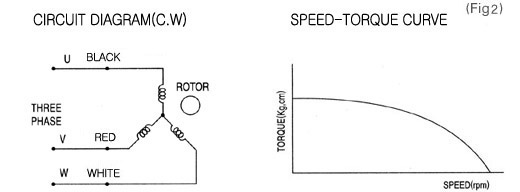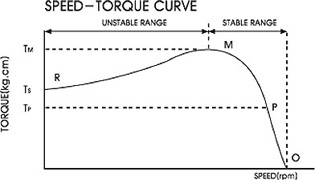Loading...
※ The induction motor is classified into a single-phase motor and a three-phase motor according to the using power source. This motor always uses both auxiliary winding and condenser not only when starting but also during operation.Generally speaking, its starting torque is not so great, but its structure is simple and reliable. In addition, its connection is simple. It is suitable to use in houses and on factories. For a single-phase induction motor, be sure that the condenser indicated in the name plate should comply with the capacity of the motor.
※ For a single-phase induction motor, it is not possible to reverse the direction of rotation within a short time during operation because of the inertia torque exerting adversely against the direction the motor is supposed to change to.Thus, stop the motor first and change the rotational direction next. In case you do not, the motor can be damaged.
※ The power source of a single-phase motor includes U(100V 50/60Hz), C(200V 50/60Hz, 220V 50/60Hz, 230V 50Hz).Refer to (Fig. 1)

※ The three-phase induction motor has simpler connection, and higher efficiency and reliability than the single-phase motor, because it can be driven by a three-phase power source directly. The three-phase motor is popular as a general-purpose motor. The power source for a three-phase motor includes H(220V 60Hz,230V 50/60Hz), M(380V 50/60Hz), Z(440V/460V 50/60Hz). Refer to (Fig. 2)

※ Under a constant voltage, the relationship between the number of rotation and the torque is as shown in (Fig. 3). With no-load, the number of rotation roughly approximates the number of synchronous rotation, but as the load increases
※ When the load is further increased and over the point TM, that is, the torque of the motor reaches the unstable zone, the motor stops and restriction electricity runs. As a result, the motor generates high heat, and then it can be damaged. Therefore, a safe operation is possible if only the motor is used within the stable zone of the load

※ The characteristic of voltage can be represented by the torque's characteristic about the applied voltage. The torque of induction motor changes in proportion to two times the voltage.
※ The characteristic of torque also change according to the capacity of the condenser. As the capacity of the condenser boost, the starting torque and stalling torque increase. But if the capacity is increased by 2.5~3.0 folds, the operating torque decreases and the starting torque do not increase.
※ As a simple method to increase the torque when the induction motor is short on torque, either the voltage or the condenser capacity can be increased to continue the operation. In this case, the loss input of the motor increases and the temperature rises rapidly.
※ However, if the motor must be run with insufficient torque, take measures to let the motor release heat as much as possible and operate the motor while keeping the temperature of the motor's housing below 90℃.
| Item | Specification |
|---|---|
| Insulation Resistance | 100MΩ or more when 500V megger is applied between the windings and the housing after rated motor operation under normal ambient temperature and humidity |
| Dielectric Strength | Sufficient to withstand 1500V at 50/60Hz applied between the windings and the case after rated motor operation under normal ambient temperature and humidity |
| Temperature Rise | Class A (below 65deg), class E (below 75deg), class B (below 85deg)(measured by thermometer after rated operation) |
| Insulation Class | Class E(120℃),Class B(130℃), UL approval motor class A (105℃) |
| Overheat Protection Device | Built-in thermal protector (automatic return type) : Open 130℃±5℃ Close 82℃±15℃ |
| Ambient Temperature | -10 ℃ ~ + 50 ℃ (UL, CE certified motor is -10 ℃ ~ 40 ℃) |
| Ambient Humidity | 85% maximum (non condensing) |